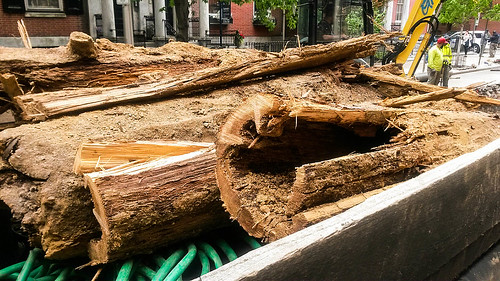In a city as old as Philadelphia, there's a chance you'll come across something historic pretty much any time you put a shovel into the ground.
That was the case on Wednesday, May 3, as workers replaced a water main along the 900 block of Spruce Street. During their excavation, they came across what looked like old logs:
They were quickly tossed aside and were headed to the trash.
Amazingly, an observant citizen whom—as luck would have it—had previously heard our in-house historian, Adam Levine, speak about Philadelphia's water history, saw the excavated pit and thought the “logs” looked distinctly like pipes.
That's when Julie Snell, a Passyunk Square resident, recalled Levine describing a network of wooden water mains that served as the city's earliest tap water infrastructure.
She brought the find to our attention by quickly looking up Levine and emailing him. History, saved.
How old?
After some research, Levine confirmed that were indeed mains and found that the pipe was most likely installed around 1812—a time when the Fairmount Water Works had yet to be completed and drinking water was still being delivered via gravity from the Centre Square Water Works, which stood where City Hall is today.
Thanks to her, Levine, and diligent PWD construction engineer Mike Schramm, the old wooden pipes have been saved and stored in a safe location and will be used for educational demonstrations.
Since the discovery, this blog post was picked up by newspapers and media outlets all over the country and globe, from the Philadelphia Inquirer and the Washington Post to the U.S News and World Report and the Associated Press.
“It's so cool that these old mains have been preserved now,” said Snell. “It's funny because I was annoyed that the bike lane was blocked, and so I was walking my bike on the sidewalk and almost went right by them. But then I noticed what looked like a tree trunk, and I got interested. I'm an arborist and so a bit of a tree geek, and this didn't look like a normal tree. I'm glad I could call attention to this little piece of our history.”
Incidentally, Snell also teaches a class at Temple University called Green vs Gray: Improving and Sustaining Urban Ecosystems, where she often talks about Philadelphia infrastructure, from early water and sewer systems to the Green City, Clean Waters green infrastructure projects happening now.
After Levine and Schramm came out to the site and confirmed that the pipes were indeed wooden water mains, Levine began researching old records in the PWD archives.
Per his findings, a Watering Committee (an early version of the department that became PWD) report made on Nov. 5, 1812 notes that pipe was laid “Back of Spruce, from Ninth to Tenth” between October 1811 and October 1812, and lists other pipes laid in the same year near this block.
More from Levine:
“Starting in 1819, the city began laying cast iron pipes as well as wooden ones. After 1832 all new pipe laid was cast iron, and the existing wooden pipes were gradually replaced.
The wooden pipe dug up today had been replaced, in 1831, by a 12-inch cast iron main. These replacements continued until 1858, when the last wooden pipe was taken out of service (if not out of the ground).
As the photos show, the pipe found today was mostly rotten, but a couple of sections were salvaged and will be moved a storage space.”
The PWD Archives is dedicated to preserving the history of the department, which began supplying the city with water in 1801.
Yesterday's find wasn't the first time wooden water mains became a topic of public interest. Last year, we shared some images of wood mains from the archives to help dispel a sort of urban myth contending that some customers are still served by wooden mains–something that's impossible, given the fact these old structures would virtually explode under the water pressure within our modern delivery system:
Anyone interested in perusing the collection, which numbers more than 30,000 items—or adding to it with historic material in their possession—can contact Adam Levine, PWD Historical Consultant, at Adam.Levine@phila.gov
Want to learn more about water history in Philadelphia?
Stop by the City Hall Courtyard this summer for a special (soon to be announced) pop-up installation that will have some information about the Centre Square Water Works, or go to Levine's PhillyH2O.org site, where you'll find troves of information and research.
